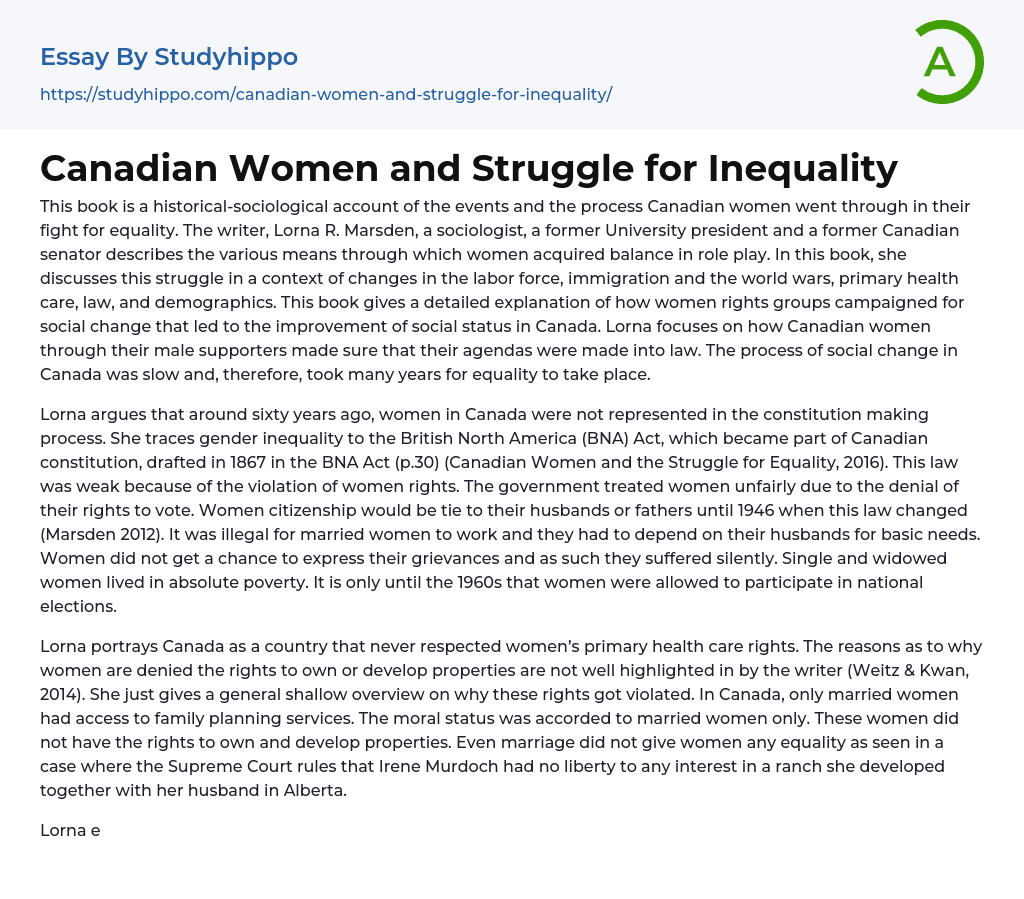In this book, Lorna R. Marsden, a sociologist, former university president, and former Canadian senator, explores the historical and sociological aspects of Canadian women's pursuit for equality. She examines the different strategies employed by women in order to find a harmonious balance in their societal roles. Marsden delves into this struggle within the framework of changes in the labor force, immigration patterns, world wars, primary health care systems, legal frameworks, and demographic shifts.
The text discusses the efforts of women's rights groups in Canada to bring about social change and improve their social standing. Lorna emphasizes the role of Canadian women and their male supporters in ensuring that their advocacy resulted in legal changes. The process of achieving social change took many years before achieving equality. Lorna argues that just sixty years ago, women in Canada were excluded from the constitution-making
...process. She attributes gender inequality to the British North America (BNA) Act, which was incorporated into the Canadian constitution drafted in 1867 under the BNA Act (p.30) (Canadian Women and the Struggle for Equality, 2016).
The law that infringed upon the rights of women was not effective. Government unfairly withheld voting rights from women, tying their citizenship to their husbands or fathers until 1946, when the law was changed (Marsden 2012). Furthermore, it was illegal for married women to have employment during this time, making them dependent on their husbands for essential needs.
According to Weitz & Kwan (2014), the writer does not sufficiently highlight the explanations for denying women's property ownership and development rights. Consequently, women's grievances remained unvoiced, and they endured their suffering in silence. Single or widowed women experienced profound destitution while Canada neglecte
to value their essential healthcare rights. It was not until the 1960s that women were finally granted the chance to engage in national elections.
Family planning services in Canada were exclusively provided to married women, granting them moral status. However, these women were not granted property ownership and development rights. This inequality extended even within marriages, as shown by the Supreme Court ruling in Irene Murdoch's case. Despite this, Lorna recognizes the progress made by women's rights organizations in their fight for equality.
While the Canadian government typically disregards women's rights in non-war times, it becomes apparent that respect for these rights is only demonstrated during periods of war. Ideally, the government should have recognized and endorsed women's rights even before World War I and II (Weitz & Kwan, 2014). Nonetheless, the advancement of human rights is frequently linked to significant historical occurrences such as war.
The Canadian government's recognition of the significance of women in the economy stems from their involvement in the First and Second World Wars, as most men were engaged in combat during these periods. Consequently, their wives faced challenges in providing for their families. Canada's acknowledgment of women's role in economic development can be attributed directly to these global conflicts (Marsden 2012). Lorna contends that suffrage rights should have been granted to women much earlier, expressing discontent with the government's delay in enacting laws that grant women voting and political candidacy privileges. As per Lorna's book, it depicts women as feeble leaders who are unfit for holding public positions (Marsden 2012).
On January 1, 1919, women were granted the right to vote, marking the end of discrimination in national elections and their pursuit of
political positions (Marsden 2012). However, Lorna argues that it was World War I that truly revolutionized women's political rights. Lorna advocates for women's involvement in the military as they possess the ability to safeguard the nation from external threats through active participation in wars (Weitz & Kwan, 2014). Prior to World War I, women were not enlisted into the Canadian military and their participation in defending the country against external attacks seemed improbable. The war introduced permanent roles for women within the military (Marsden 2012).
Women have held positions in both elected parliaments and the military as commissioned officers throughout history. The book acknowledges the impact of historical and social events on advancing women's rights. In modern society, women now have equal rights to men. Although many women work today, they still shoulder the responsibility of childcare. Nonetheless, this book ultimately commemorates the significant progress made in empowering women's societal roles.
Despite facing ongoing challenges in areas such as healthcare, domestic violence, and workplace discrimination, organizations advocating for women's rights have made considerable strides towards achieving equality. Lorna's book offers a thorough examination of this progress, highlighting both the accomplishments and remaining obstacles. However, it fails to acknowledge the valuable support provided by men in empowering their female peers. Nonetheless, these achievements serve as inspiration for individuals today to persist in their efforts. Despite some flaws, Lorna's book presents remarkable sociological perspectives on the historical events that have shaped women's quest for equal rights.
Students studying history and gender studies will always find value in this book.
References
- Canadian Women and the Struggle for Equality. (2016). CanadasHistory. Retrieved 6 March 2016 from http://www.canadashistory.ca/Books/Lire-sur- l%E2%80%99histoire/Reviews/Canadian-Women-and-the-Struggle-for-Equality
(2014). The politics of women's bodies: Sexuality, appearance, and behavior.
- Gender Inequality In The Workplace essays
- Alaska essays
- Boston essays
- Brazil essays
- California essays
- Canada essays
- Chicago essays
- Costa Rica essays
- Florida essays
- Hawaii essays
- Latin America essays
- Los Angeles essays
- Mexico essays
- Slavery In America essays
- Usa essays
- Virginia essays
- Washington essays
- Equality essays
- Gender equality essays
- Gender Inequality essays
- Minority essays
- Segregation essays
- Social Inequality essays
- Domestic Violence essays
- Gun Violence essays
- Media Violence essays
- Video Game Violence essays
- Violence Against Women essays
- Violence in Video Games essays
- Youth Violence essays




